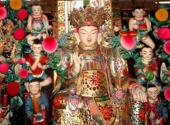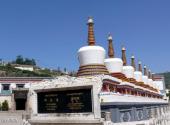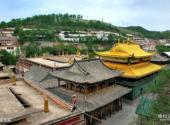
Scenic spot introduction:
Kumbum Monastery is one of the six major monasteries of the Gelug Sect (Yellow Sect) of Tibetan Buddhism in China. It is the birthplace of Tsongkhapa, the founder of the Yellow Sect of Lamaism, the center of Buddhist activities in the northwest region, and the leading scenic spot in Qinghai Province. This temple is famous not only in China, but also in Southeast Asia. The central governments of all dynasties have highly praised the religious status of Kumbum Temple. In the Ming Dynasty, the upper-level religious figures in the temple were granted many titles. Emperor Kangxi of the Qing Dynasty awarded the plaque "Jingshang Jinliang", Emperor Qianlong granted the title "Fanzong Temple", and the Dajinwa Temple was awarded the "Sanskrit Dharma Pillar" plaque. The Third Dalai Lama, the Fourth Dalai Lama, the Fifth Dalai Lama, the Seventh Dalai Lama, the Thirteenth Dalai Lama, the Fourteenth Dalai Lama and the Sixth, Ninth and Tenth Panchen Lama all performed at Kumbum Monastery. Celebrate religious activities.Kumbum Monastery is located in Huangzhong County, 25 kilometers southwest of Xining City, and in the southwest corner of Rushal Town. The huge building complex is distributed on one ditch and two slopes of Lianhua Mountain. The palace, Buddhist hall, study hall, dormitory, the residence of the lamas, and the courtyard complement each other and are integrated into one. The architecture covers the styles of Han palaces and Tibetan flat roofs, and uniquely combines the Chinese three-eaves mountain style with the Tibetan eaves' ingenious whip building. The hemp walls, the Kalachakra Sanskrit mantra inlaid in the middle, the bronze mirrors, and the bricks on the bottom are integrated into one. The temple is stacked on top of the mountain, winding and undulating, well-proportioned and majestic. The temple has towering ancient trees and numerous pagodas, and the scenery is magnificent and extraordinary. In particular, the butter flower sculptures in the temple are the most famous, lifelike and very beautiful.
Kumbum Monastery is also one of the high-end institutions of higher education that has cultivated a large number of Tibetan intellectuals. The temple has four major schools: sutra, esotericism, astronomy, and medicine. It can study Buddhism and Tibetan language, writing, astronomy, calendar, medicine, dance, Sculpture, painting, architecture and other aspects of knowledge. Four large-scale temple-wide Dharma assemblies are held in the first month, April, June and September of the lunar calendar every year. At that time, people from all over the country will gather in large numbers. In addition, in late October of the lunar calendar, there is also the "Five Lighting Festival" to commemorate the death of Tsongkhapa and the year-end event to send the God of Plague away.
Attractions distribution:
Kumbum Temple covers an area of 450,000 square meters, including Dajinwa Temple, Xiaojinwa Temple, Flower Temple, Dajing Sutra Hall, Jiujian Hall, Dalalang, Juba Zhacang, Dingke Zhacang, and Mamba Zhacang. , Ruyi Pagoda, Taiping Pagoda, Bodhi Pagoda, Guomen Pagoda, Xianzong Sutra Academy, Tantric Sutra Academy, Medical Ming Sutra Academy, Shilun Sutra Academy and other large and small buildings, a total of more than 1,000 courtyards and more than 4,500 temples and monks' houses. Butter flowers, murals and embroidery are known as the "three wonders of Kumbum Temple art". The temple also houses many Buddhist classics and academic monographs. The annual Buddhist activities "Four Dharma Assemblies" are even more lively.Scenic spot qualifications:
National 5A-level scenic spot, national key cultural relic protection unitScenic spot features:
Cultural tours, photography, sightseeing, historical tours, religious tours, temples, monumentsScenic spot map:
Travel Notes of Travellers:
- Iron Egg: Journey to the Yellow River Series 3: Gaoxia Pinghu
- Travel Guide: Xining Free Travel Guide for Three Days 2018
- Tiedan: Heavenly Qilian (V) Hainan
- Tiedan: Heavenly Qilian (II) Ganzhou Chapter
- Iron Egg: Heavenly Realm Qilian (1) Haidong Chapter
travelling guideline:
Eat: You can dine at the pilgrim hotels around the monastery, where a large bowl of Tibetan noodles, vegetables and tea only costs 5 → 8 yuan.
Accommodation: Accommodation is cheap at the Pilgrim Inn. If you want to be more comfortable, you can stay at the Kumbum Temple Hotel, a large and new hotel across the canyon facing the monastery. It is on the left of the entrance to the monastery.
Tour route:
The scenic area is not big, so you can visit each temple in sequence on foot.
Best time to visit:
May-September
Shopping recommendations:
When you leave the main entrance of Kumbum Monastery, you will see souvenirs selling along the street. Most of them are Tibetan jewelry. They are very beautiful, but you must bargain.
Scenic spot map:
Scenic spot location:
China>Qinghai Province>Xining City>Huangzhong County
How to get there:
You can take buses to Huangzhong County at the Xiaoximen Bus Station next to the stadium on the west side of Xining and the Zhifang Road Bus Station in the west of the city, leaving at any time. You can also hire a taxi from Xining. It takes 20 minutes to walk north from Huangzhong County Bus Station to the entrance of the monastery.
Scenic area map:
Click to expand the scenic area map
Ticket prices for Kumbum Monastery:
1. Tickets: 80 yuan. Tickets are free for active military personnel, disabled military personnel, retired military cadres, preschool children, etc.; half-price discounts are provided for students, the elderly, and disabled people.
2. Guide fee: determined based on the number of people, 20 yuan/person for 5 people. For more than 5 people, 10 yuan/person. Teams of more than 20 people charge 5 yuan/person.
Scenic area opening hours:
7:30-18:00 (May-October), 8:30-17:30 in other months








